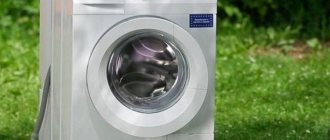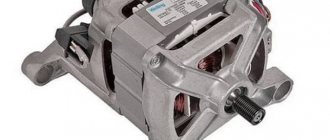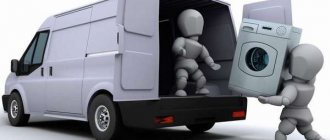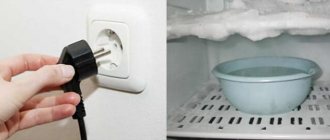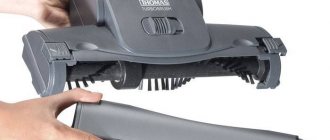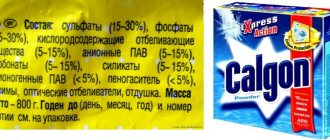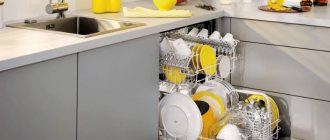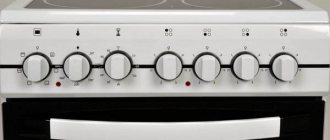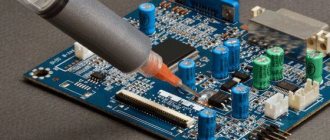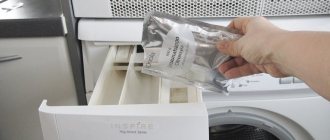Today, a washing machine is found in almost all homes, and a modern housewife can no longer imagine her life without it. This technique helps a person take care of clothes; most models have various additional options that allow you to save energy during washing. But how it works is still a mystery to many. For those who are planning to independently repair the components of their washing unit, it would be useful to know the structure of the washing machine.
Basic elements of an automatic washing machine
Modern automatic washing machines operate on the same principle, regardless of the brand or manufacturer. But some may differ in engine type, loading method and additional features. Let's look at the main elements of the unit in more detail.
Electric motor
The centrifuge equipment rotates due to an electric motor. The operation of any of them is based on electromagnetic induction. Despite the large number of electric motors, the following are used in washing machines:
- Collector.
This is a subtype of DC motors that can also operate on alternating current. Its active use began in the 90s, but already by the 2000s. The electric motor was completely replaced by two-phase asynchronous devices. The basis of the commutator motor is a stator, a rotor, a tachogenerator of an aluminum housing and several brushes so that the rotor can contact the motor. The brushes are not universal; they quickly wear down on the commutator, and, as a result, periodically require replacement. The main advantages of the motor include: compactness, high starting torque, versatility, simplicity of the main electrical circuit, lack of connection to the mains frequency, smooth speed control. Significant disadvantages are the short service life, high noise level during operation and the need for periodic replacement of brushes. The commutator-brush assembly breaks down much more often than other parts. This is due to the fact that friction in this area causes sparking, causing overheating and separation of the collector lamellas from the insulator. - Asynchronous.
It can be two- and three-phase. The production of two-phase ones was discontinued back in the 2000s; they were replaced by more modern and compact three-phase devices that allow frequency control of speed. Such motors consist of two parts: a stator and a rotor, a drum, that causes rotation. The rotation speed can reach 2800 rpm. The most common failure is considered to be a weakening of the torque, which causes the drum to become unstable, may sway to the sides and not complete full rotations. The main advantages of use include: easy repair and maintenance, most often it is enough to simply lubricate the bearings and replace the motor, absence of noise during operation, simplicity of design, affordable price. The only negative is the large size of the motor, difficulty in controlling electrical circuits and low efficiency. Most often, such electric motors are found in budget washing machines. - Direct drive.
It is also known as brushless motor or inverter motor. Its widespread use began in 2005, and since then, due to a number of advantages, such as compactness and durability, it has firmly established itself as a leader. The motor consists of a stator and a rotor. The operating principle is based on a drive that is connected directly to the drum, which eliminates the need to use the most vulnerable parts of any engine - connecting elements. The main advantages include: simplicity of design, ease of use, low noise level during operation, compactness, high efficiency.
The main disadvantage is considered to be a rather complex control circuit, which increases the cost of such washing machines several times.
heating element
This is an electric heater designed to heat water coming from a hose connected to the central water supply. It is made from a V- or W-shaped tube. Inside there is a conductor element that has a high resistance, thanks to which the heating element is able to withstand overheating and high temperatures. Around the spiral there is a dielectric insulator, which absorbs the heat coming from the heating element and transfers it to the outer steel part.
Next to the working spiral there is a thermal unit that measures the level of water heating in the tank. When a command is given through the control panel in any mode, the heating element begins to work. It gets very hot, and due to heat transfer, the water in the drum is also heated to the desired temperature.
In the event of a breakdown, knowing where the heating element is located is extremely important, since the speed of repair depends on it. Therefore, the user needs to look behind the back panel and check the size of the cover located there. If it is large, then the heating element is often located directly under the washing tub. In this case, to get the heating element, you need to unscrew the back wall. But if the cover is small, it is often used as a hatch that leads to the belt. In this case, the heating element is located directly behind the front panel.
Drum and tank
In practice, these two concepts are often confused with each other. The laundry is loaded into the drum, and the tank is used as a container for water with powder added to it, which gets inside through perforated holes.
Any drum, regardless of brand, is made of stainless steel with a perforated side surface. The main advantage of this material is its high reliability. With tanks the situation is a little more complicated, since they are made not only from different materials, but also give the products different shapes. You can find plastic, stainless steel and enamel tanks on sale. The latter was discontinued not long ago due to low resistance to chipping and mechanical damage. While plastic is becoming increasingly popular due to its lightness, quiet operation and high corrosion resistance.
Cuff
In simple words, a cuff is a rubber seal that is installed in the area of the washing machine hatch. It provides sealing during the process of clogging the tank during operation of the equipment. This is why water does not flow out. The location of the part is affected by the model of the washing machine. In front-loading washing machines, it has a round shape and is needed to connect the tank to the front wall. When loading vertically, the seal has a rectangular shape and connects the tank and the upper wall.
Dispenser tray
Usually, in modern automatic machines, regardless of the type of load, a special compartment is built into which powder and washing conditioner are added. When loading horizontally, the dispenser tray is located at the top, close to the control panel. When loading vertically, the hatch must be opened before reaching the powder compartment. The dispenser can be located directly on it or next to the hatch. In most devices, the tray is divided into three parts, the purpose of each can be determined by the sign painted on it:
- Roman numeral I or Latin letter A: stands for prewash tray. Powder is poured here if the washing takes place in two stages. So, the detergent will enter the drum at the first stage.
- Roman numeral II or Latin letter B: also designates the main wash compartment, and it does not matter which program the user has chosen.
- A flower or star is a compartment designed for conditioner or rinse aid. Such products are usually sold in liquid form, and they are poured both during the haircut and at the very beginning. It is important to do this before the machine starts to fill with water for rinsing. Otherwise, the product simply will not get into the drum.
Water supply system
It includes an inlet valve, an inlet filter and pipes that connect the dispenser to the hose through which water enters the tank. The purpose of the inlet filter is to prevent large debris from leaking from the water supply into the machine. It is located in the same place where the water supply hose to the device is attached. This is often a round, metal or plastic mesh. The inlet valve is needed to supply water to the tank and dispenser, it also stops its flow.
Water drain system
The main purpose of the drainage system is to discharge dirty water into the sewer system. Its installation can be carried out in different ways:
- Using a siphon. If the equipment will be in the kitchen, then the most rational solution is to connect it to the drain using a siphon. This will ensure the drainage of wastewater not only from washing equipment, but also from other devices. In this case, replace the simple siphon with a combined one, which has more options for drainage. Such products are used when installing sinks, washing machines and dishwashers.
- Using plumbing. A curved plastic latch is found in almost every machine today. Its main function is to secure the drain hose to the edge of the toilet, washbasin or bathtub.
- Horizontal outlet. Many apartment owners install a horizontal drain, directing it under the bathroom, directly into the sewer pipe. This method has one significant drawback - an unpleasant odor in the room, the drain hose and inside the device.
- Direct connection. If the point of entry into the sewerage system is far from the washing machine, then you will have to install a branch leading to the installation site.
Electronic module, sensors and control panel
The control panel is responsible for all processes occurring in the washing machine. Using buttons, the selected commands are transmitted to the center of the device - the electronic module. It is he who is the “brain” of the system and manages all stages of washing, giving the necessary commands to all components. This became possible thanks to the memory, which has built-in special programs and functions. Their variety is influenced by the user himself, choosing a budget or, conversely, an expensive model. To effectively monitor the operation of the machine, the module interacts with sensors: pressure switch, thermostat, tachometer, hatch closing sensor, etc.
They transmit information from different components of the washing machine. It can be displayed on the display located at the top, or displayed using light indicators, it all depends on the device itself. Today, modern washing machines are equipped with a liquid crystal display, which displays the washing process and errors made during the process. Moreover, in models with front loading, the control panel is located on the front wall, and in vertical ones - on the top panel.
Balancing system
The tank and drum are large in weight and volume, so strong vibration is felt during washing. To reduce it, a system of counterweights is built into the body of the washing machine - concrete blocks fixed at the top and bottom of the tank. They reduce noise and vibration that occurs during the process. In addition, shock absorbers are installed on the tank, and special springs hold it at the top, which also reduce vibration.
Washing machine body and its components
Its design is quite simple - front, back and two panels on the side, top cover. The front part consists of a hatch door, a lock and a rubber seal. Some models have a small window on the door through which items can be added during washing. As mentioned earlier, the cuff ensures a tight fit of the door and protects against water penetration outside. The lock mechanism is directly connected to the control module, which prevents the door from being opened while the device is washing. At the bottom of the panel there is a small door behind which the drain filter is hidden. The back panel is most often solid.
Thermos tank for shower
Everything breaks down someday. Washing machines and refrigerators are no exception. If your equipment has definitely become completely unusable and cannot be repaired, do not rush to throw it in a landfill. There are many options for using old washing machines and refrigerators, both quite practical and decorative.
Flower pot from the drum of an old washing machine. It’s quite nice and roomy, it’s not afraid of moisture, it will last a long time, because metal is a very reliable material. This plant pot can be painted any color.
The entire washing machine became a flower bed, even a container for detergent and rinse aid was used. Of course, such a piece of household appliance surrounded by greenery looks a little strange, but overall it is a very interesting option, an original element of landscape design.
The most popular way to use an old drum from a washing machine is as a barbecue. You can cook not only kebabs over wood and coals; both a saucepan and a frying pan can conveniently fit on top. At the same time, making such a grill is very simple.
This is an improved version of the barbecue made from a washing drum, on a tripod. By the way, the design turns out to be quite light and easy to move around the site. As an option, it was possible to equip a stationary place for an outdoor fireplace by arranging a convenient area around the drum.
And who will say that it is not beautiful - the reflections of the flame in the holes of shiny metal. Such a grill does not look like an old and useless thing, but a relevant and practical element of a personal plot.
From a very old washing machine, or rather, its rounded metal body, you can make a smokehouse for fish and meat products.
This is how a washing machine drum can look elegant, designed by a designer or homeowner with a rich imagination. By the way, in the empty body of such a cabinet-seat with a soft cushion it is quite possible to store all kinds of small things.
And again the flowerbed is in a whole washing machine. Beautiful bright petunias smoothed out the brutality of the unsightly metal body of the equipment, which clearly served for many years until it turned into a flowerbed.
Cabinet in an old refrigerator. The body has been painted, there are not many shelves, but they are quite spacious, and the former freezer fits various small items.
Even if the refrigerator itself refuses to freeze, this cannot prevent you from using it to cool drinks during an outdoor party. The simple decoration with wooden boards looks quite attractive, and the ice under the hinged lid will last for a long time.
An incubator in an old refrigerator. It will retain heat, especially if you add additional insulation; you only need lamps to heat the eggs and a thermometer to monitor the temperature. A good option for those who want to start raising chickens.
House for puppies. It turned out to be a separate sleeping area and dining area. For a larger dog, the refrigerator body would also be suitable as a sleeping place; you just need to remove the shelves.
Chest for potatoes and other vegetables. If there is no cellar, this is a good place for storage. A refrigerator dug into the ground will heat and cool slightly, making it less likely that the potatoes will sprout or, conversely, freeze.
The washing machine has long become a familiar part of the interior of most apartments and houses. But nothing lasts forever, and over time, this valuable household appliance breaks down. Don’t think that now that the machine is broken, it won’t be of any use. It consists of various spare parts that can be used separately on the farm.
Features of top-loading washing machines
Horizontal loading equipment is used everywhere, but many users choose vertical loading devices because they have a number of advantages. First of all, it is compact in size, allowing the unit not to take up much space and fit perfectly into the interior.
The main difference between this type of machine is that the loading lid is located vertically. Such devices do not have a transparent door in the front part. In addition, today there are washing machines on sale that use special mechanisms that are responsible for stopping the drum with the flaps facing up when the wash is finished.
The second feature of such devices is two equally located shafts on both sides of the drum, responsible for rotation. The control panel is also located differently, on the rear of the loading hatch. The permissible weight for washing items that can be loaded is determined by standard rules for all similar devices from any manufacturer.
Pros and cons of a top loading washing machine
Vertical washing machines have both advantages over front-facing models and lose to the latter in some aspects.
Advantages:
- Small size. The laundry capacity of the two machines is the same, but the dimensions of the vertical devices are much smaller. So, they can be used in apartments with limited space.
- Even if the wash has already started, you can look into the drum of the top-loading device, which allows you to add items at any stage of the wash.
- Ease of use. Top loading makes loading laundry much easier. The user does not need to constantly bend down and sit down.
- Child protection. Since the control panel is at the back, it will be more difficult for children to reach.
- Noise protection. Vertical models vibrate less during spinning, which means the noise level will also be low.
- Long service life. Two bearings on which the drum is supported reduce the risk of equipment breakdown due to overload.
Minuses:
- The price of such devices is much higher compared to front-loading models.
- A little variety.
- It will not be possible to integrate the machine into a kitchen set or other furniture structures.
Design of activator washing machines
They were used long before automatic washing machines came on the market. Despite the fact that modern devices are equipped with a number of useful functions, activator-type units can still be found on sale. Activator washing machines are:
- Simple. These are machines with manual spinning and without additional functions.
- Semi-automatic machines with a centrifuge for spinning clothes. They can be equipped with additional functions, for example, water heating or delicate washing.
- Automatic cars. The main difference lies in the washing mechanism (an activator-impeller is used). Water supply, rinsing and spinning are performed by the unit independently; the user only needs to select the appropriate program.
The design of activator washing equipment includes 4 main parts. Tank, electric motor, activator and timer. An activator is a plastic part with ribs or blades, the main task of which is to rotate the laundry and water inside the tank. The torque is transmitted to it by an electric motor.
An asymmetrical blade activator is built into inexpensive machines of this type that do not have additional functions. It is a cone-shaped screw that rotates inside the tank clockwise and mixes the things inside. They wash out quite quickly, and the design itself is simple and reliable. The main disadvantage is that when washing this way, the laundry often clings and gets stuck inside the tank, which can cause it to become unusable.
Modern models have an impeller built into them - a bell with symmetrical ribs that differ in size. It is able to change the rotation speed and trajectory of movement. Large blades allow you to create a powerful funnel flow. Medium ones are needed for working with delicate fabrics, and very small ones, located around the perimeter, create additional water flows that allow you to efficiently remove stains and dirt of various kinds. The main advantage is that the complex trajectory of movement will prevent the laundry from twisting. To get started, you need to put things in the tank, pour water at the desired temperature and add laundry detergent. Upon completion, the dirty liquid must be drained and clean liquid must be collected for rinsing.
Pros of use:
- There will be no problems with foam formation during use.
- Simple semi-automatic models can significantly save water.
- Budget equipment that is not equipped with a heating element allows you to save energy. This is due to the fact that water is poured into it already heated to the desired temperature, and the machine spends electricity only on operating the engine.
Minuses:
- Budget models do not have a spin cycle.
- The input is drained manually; it needs to be changed periodically, which is very inconvenient.
Some useful tips
If you don’t yet have a washing machine at home, when purchasing, pay attention to the following points:
- Look at the material the drum is made from. Washing machines with stainless steel drums are considered more reliable.
- Wonder what the maximum rotation speed of the drum is.
- Check to see if the machine has a drying and rinsing function.
- Pay attention to the drum volume and the list of programs.
If we talk about how an automatic washing machine should work, then everything is quite simple. All washing processes are set by the user, choosing a mode, temperature, and spin speed. In general, the washing chain is as follows:
- Loading funds into a cuvette.
- Loading laundry.
- Selecting a program (or washing parameters).
- Start the wash cycle.
- Water intake.
- If required, heat the water.
- Wash.
- Draining.
- Rinsing.
- Draining.
- Spin.
As a result, you get clean and almost dry things.
Washing machine maintenance
These steps should be performed at least once a month:
- Inspect the detergent tray. If the detergent dispenser clogs due to insufficient water pressure or using too much detergent, the clothes will not be washed properly.
- Cleaning a glass door. Limescale and other hard particles can allow water to seep between the glass and the seal.
- Seal. If the cuff sticks to your hands, it's a sign that it's time to replace it.
How to choose?
Before choosing, it is necessary to calculate the maximum current strength that the protection must pass. This is quite easy to do. As you know, current power is determined by the formula P = I*U, where power P is measured in W; I – current strength, A; U – network voltage, U = 220 V.
The power of the washing machine P can be found in the passport or on the back wall. Usually it is 2-3.5 kW (2000-3500 W). Next, we derive the formula I = P/U and after calculation we obtain the required value. It is 9-15.9 A. We round the resulting value to the nearest larger number, that is, the maximum current strength is 16 Amperes (for powerful machines). Now we select the circuit breaker based on the current strength found.
The situation is slightly different with the choice of RCD. As already mentioned, if the power is slightly exceeded, the AO does not operate for a long time, and the RCD places an additional load. This shortens the life of the device. So the current rating of the RCD should be one step higher than that of the AO. This is explained in more detail in the next video.
Let's give some general tips on choosing protection devices.
- For stable operation of all devices, it is recommended to use voltage stabilizers.
- The optimal RCD leakage current should be 30 mA. If it is more, then the protection will be unsatisfactory. If it is less, there will be false alarms caused by the high sensitivity of the sensor.
- For household use, it is recommended to use machines marked C. For a socket network, it is advisable to use a C16 machine.
- The optimal class of RCD is A. Devices of the AC group may not always operate correctly.
- It’s better not to skimp on protection. Buy only high-quality devices from reputable manufacturers. Remember that the cost of the most expensive washing machine will be much lower than the price of a new washing machine.
Now the selected device needs to be connected.
General recommendations
An Indesit brand washing machine is traditionally not burdened with unnecessary electronics - touch panels, remote and voice control, wide color displays. On the one hand, this makes it somewhat old-fashioned and unattractive for lovers of modern gadgets, but on the other hand, it makes it much cheaper, and therefore potentially more attractive to consumers.
The lack of newfangled electronics does not lead to the fact that the washing machine begins to wash worse; rather, on the contrary, its control module is simpler, and therefore more reliable
But the quality of washing depends not only on the equipment, but also on the users who turn it on and set it up, so to get the best results it is very important to use the Indesit washing machine correctly. To begin with, here are some general recommendations that it would be nice for everyone to know:
- When placing laundry in the drum, be sure to sort it. It is necessary to take into account not only the color (white/black), but also the fastness of the paint, the type of fabric, and the presence of loose elements.
- Before putting new items into the drum of your Indesit washing machine that have not yet been washed, check their identification labels. Usually, if an item cannot be washed or can be washed, but in a special mode, the manufacturer makes appropriate notes on its label. You can read more about this in the article Markings on clothes for washing.
- Always check the pockets of clothing items you place in the drum. Any needle, pin or paper clip that gets inside your Indesit washing machine can seriously damage it. Not many people will feel better if you wash your passport or credit card in the machine, so it’s up to you whether you want to start such a healthy habit or not.
- Always check that the buttons on the clothes you are going to wash are secure and fasten all zippers. And clothes with plastic zippers are generally best washed in a special bag.
- For best washing results, it is better to turn T-shirts, shirts, sweaters, jackets, pants, socks and other clothes inside out.
- To better balance the drum, do not wash many large items at once, divide the wash into two or even three batches and mix large items with small ones.
- Do not use hand washing powders as they will cause excessive foaming.
- Place detergents in the tray correctly. Each type of detergent has its own powder receptacle compartment: the first compartment for pre-wash, the second for the main wash and the third for rinse aid.
- If you wash clothes without heating the water, then you need to put in half as much powder. Otherwise, it will not dissolve and will be removed along with waste water - money down the drain.
- The choice of washing program is carried out only when the Indesit washing machine is stopped. Violation of the rule may result in damage to the control module.
Popular programs
Like any other washing machine, the Indesit washing machine has quite a few modes in its arsenal, which people use quite rarely. This always happens, we use some modes 2-3 times over the entire life of the machine, and some we use constantly. Our Italian partners conducted a survey of users of Indesit washing machines and found that they most often use the following programs:
- heavily soiled white clothes (number 1 on the program selector);
- mixed things (number 3);
- colored things (number 4);
- moderately soiled non-fading synthetics (number 9);
- wool (number 14).
The nuances of installation in cramped conditions
The most reasonable option, from the point of view of minimizing installation labor costs, is to install the machine in the kitchen or bathroom. All necessary communications have already been carried out there. But this is not always convenient for apartment owners. We have to look for another place.
In the corridor
You can park a car in the corridor if it is wide. But there are definitely no communications there. You will have to lay hoses there, and this is not at all aesthetically pleasing and not very reliable. This is a last resort option.
Under the sink
If you decide to install the machine in the bathroom under the sink, then this is convenient from an installation point of view. All the necessary pipes have already been laid. But the sink has a long drain that goes down. In this case, the best solution would be to replace the sink with a special flat one. A small-sized machine will fit well there.
Above the toilet
There is an option to install the machine above the toilet. The option is good from the point of view of saving space. But other problems arise. It will not be possible to hang the car on the wall there, since the walls in the toilet are usually plaster. You will have to build a special metal structure for the car. The unit must be placed so that it does not interfere with access to the button and the lid of the drain tank. In addition, it must be taken into account that during each repair the heavy device must be lowered from the rack and raised back after repair.
